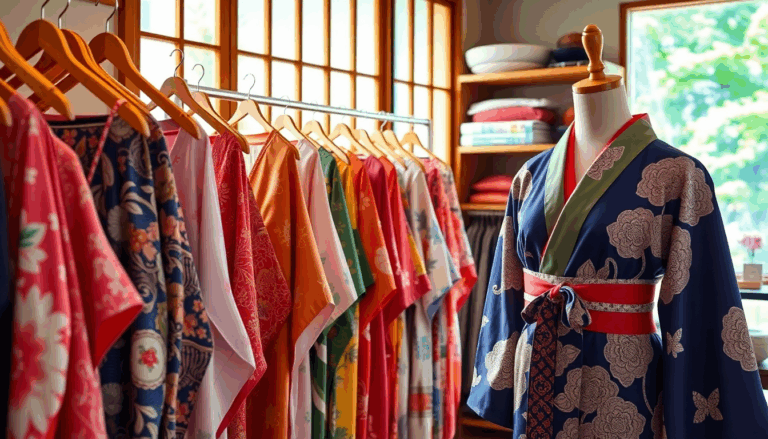Buying a kimono in Japan is more than just a shopping trip; it’s an engaging journey into a culture rich in tradition and artistry. Whether you’re after a unique souvenir or a stunning outfit for a special occasion, getting to know the differences between kimonos and yukatas can truly elevate your experience.
This guide is designed to arm you with the insights you need to navigate the vibrant world of kimono shopping, from budget-friendly markets to upscale boutiques, ensuring that your adventure is both authentic and fulfilling.
Decoding the Kimono Landscape
Before you set off on your quest for the perfect kimono or yukata, it’s important to clarify what you’re looking for. An authentic kimono is a traditional garment, often luxurious and made
from fabrics like silk, and learning to wear one properly can be quite a skill. Have you thought about the lighter, more casual yukata instead? This summer style, typically made from cotton, is much easier to wear and comes at a fraction of the price. In my travels across Japan, I often suggest considering a yukata—it’s affordable, easy to pack, and makes for a fantastic gift. While the allure of a genuine kimono is undeniable, remember that
these garments are frequently worn just once. Unless you have a deep connection to Japanese culture, opting for a yukata might be the more practical and sustainable choice.
The price tag for a complete kimono ensemble, including accessories like the obi, underskirt, and geta, can skyrocket into the thousands of euros. But don’t worry! There are plenty of second-hand options available, often priced under 100 euros—especially if you’re okay with minor imperfections. New yukatas are even more wallet-friendly, starting around 20 euros for simpler designs and going up to 100 euros for higher-quality pieces. During the summer months, it’s common to find deals that bundle yukatas, obis, and geta at fantastic prices. Can you imagine bringing home a slice of Japan without breaking the bank?
Top Shopping Destinations for Kimonos
When it comes to shopping for kimonos or yukatas, Tokyo and Kyoto are your go-to spots. In Tokyo, the famous second-hand store Chicago Harajuku boasts an impressive range of used kimonos, yukatas, and haori at reasonable prices. Here, you’ll encounter traditional garments for both men and women, featuring patterns that range from classic to contemporary. Prices typically start around 4,000 yen, while high-quality kimonos can exceed 50,000 yen. The store is well-organized, complete with fitting rooms and size guides—perfect for those eager to find the right fit. Can you picture yourself trying on various styles to discover the one that suits you best?
In Kyoto, a charming traditional shop stands out for its collection of vintage kimonos and yukatas offered at fair prices. The atmosphere is inviting, and the staff is known for their friendly assistance, allowing you to try on garments at your own pace while offering tips on styles and pairings. With prices starting around 6,000 yen, it’s an excellent destination for those seeking an authentic kimono without straining their budget. Isn’t it wonderful to have knowledgeable staff guiding you through the selection process?
Exploring Online Options and Rental Services
If you prefer shopping in larger department stores like Tokyu Hands or Loft, especially in the summer, you’ll often find coordinated yukata sets complete with obis and accessories. Uniqlo also offers yukatas during the summer months, known for their quality and convenience. If you find yourself in Kyoto, don’t miss the Nishiki Market, where a variety of shops sell both new and used yukatas and kimonos. Some of these stores have a rich history and may hide some real treasures at reasonable prices. Have you ever thought about how delightful it would be to bring home a genuine piece of Japanese culture?
If in-person shopping isn’t feasible, there are several reliable online retailers specializing in vintage and used kimonos, such as kimonoya-japan.net. While you may not get the tactile experience of feeling the fabric in person, it’s a good alternative for those comfortable with online shopping. Moreover, if the idea of owning a kimono intrigues you but you’d rather not buy one, consider renting a kimono for a few hours to capture breathtaking photos in historic districts. Many studios in Kyoto and Asakusa offer this service, letting you enjoy an authentic experience and create unforgettable memories without the commitment of a purchase.
Lastly, don’t overlook second-hand markets and stores like Book Off Super Bazaar, where you might stumble upon kimono treasures at unbeatable prices. Just remember to check the sizes, as many kimonos are designed for Japanese body types. If you’re looking for a more comfortable fit, be on the lookout for size L or LL options, which are increasingly available from Japanese brands catering to tourists. Have you envisioned yourself in a beautiful kimono while exploring the stunning streets of Japan? That dream can easily become a reality!

